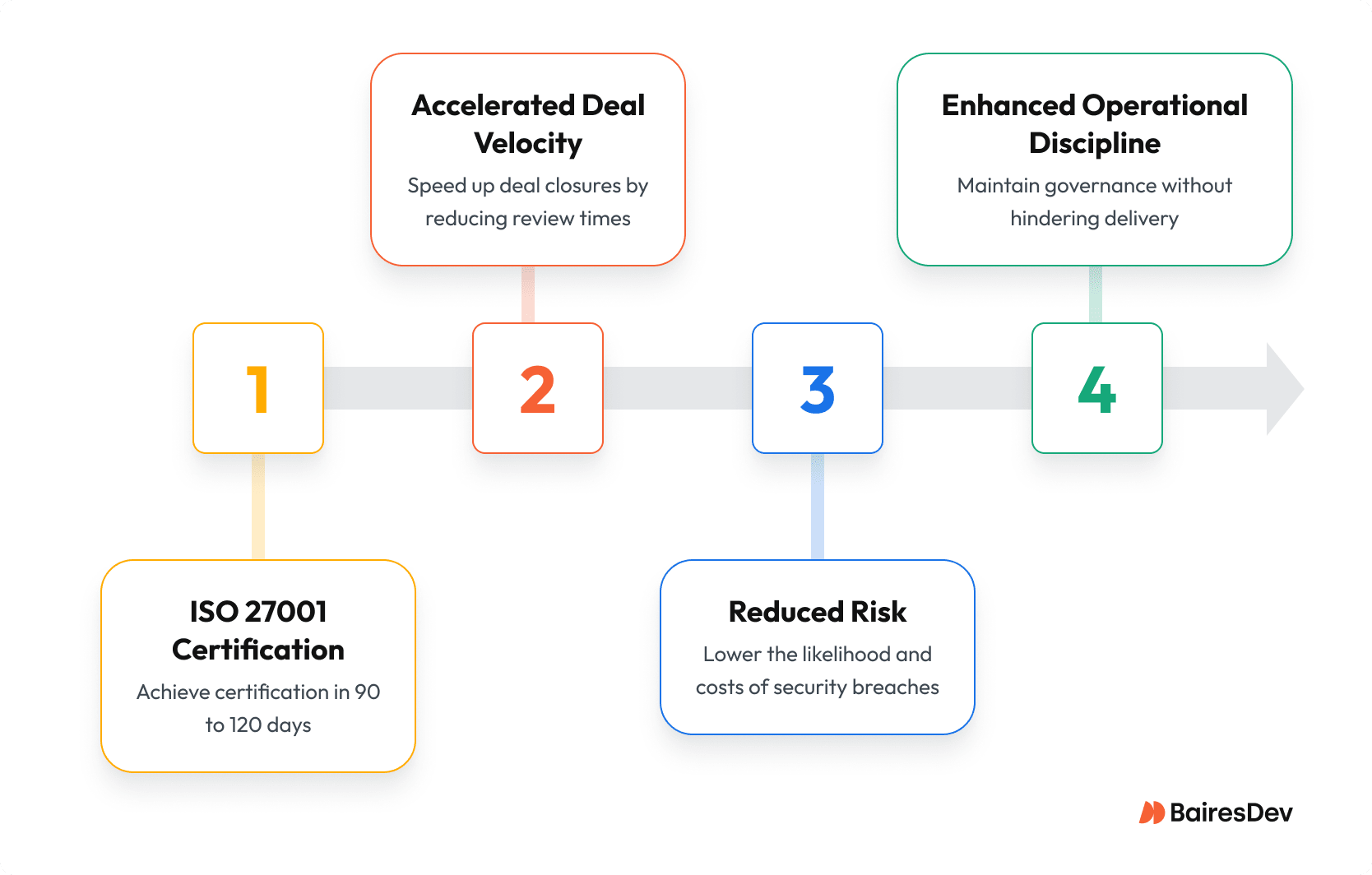Enterprise buyers rarely ask if you have ISO 27001 certification. They assume you do, and without it, many won’t even shortlist you. With certification in hand, your procurement cycles accelerate, security reviews shrink from weeks to days, and your engineering discipline becomes visible to customers and regulators alike.
ISO/IEC 27001:2022 is more than a compliance certificate. It is the international benchmark for running a disciplined information security management system (ISMS). Done right, it aligns your teams on risk management, embeds security into delivery pipelines, and creates a single source of truth for audits.
The result isn’t just reduced risk. It’s faster deals for your sales teams, stronger data security, and more resilient business processes.
“Without ISO 27001, enterprise deals stall. With it, you prove resilience, earn trust, and embed discipline into delivery.”
Why ISO 27001 Requirements Matter to You
For an engineering leader, ISO 27001 requirements are not just compliance tasks. They are commercial enablers. Because the certificate is already trusted by most enterprise risk teams, it collapses sprawling questionnaires into a single line item and pushes you onto pre-approved vendor lists.
Procurement teams explicitly call for them in vendor oversight, and regulators across industries recognize them as authoritative. Internally, the same controls that satisfy auditors sharpen delivery.
Certification removes friction outside the organization and adds discipline inside it, raising trust while your team keeps shipping.

Deal Velocity
With ISO 27001 certification, your procurement cycles shrink. Instead of dozens of security questionnaires, you present one authoritative attestation.
Many enterprise portals pre-approve ISO-certified suppliers, so legal and infosec reviews start in parallel, keeping deals on the current-quarter timeline.
What about budgeting? Typical first-year ISO 27001 spend lands between 0.8 % and 1.2 % of engineering OpEx, most of it front-loaded into gap analysis and audit prep.
Risk Reduction
Your ISMS enforces security controls and risk management processes that reduce the likelihood and blast radius of breaches.
The latest 2025 research shows the global average cost of a data breach has fallen to $4.44 million, while U.S. organizations face an average of $10.22 million, an increase of 9% year over year (IBM 2025). Breaches linked to shadow AI incidents raised costs by another $670,000 on average.
Operational Discipline
Your governance cadence, including regular internal audits, tested recovery, and continual improvement, keeps your security objectives aligned with delivery velocity.
Logs for access reviews, restore tests, and incident post-mortems flow into an evidence repository automatically, so audits pull a report. There’s no artifact-chasing or delivery slow-downs.
QUICK METRICS CALLOUT
| Metric | What It Means for You |
| $4.44M | 2025 global average cost of a data breach (down 9% YoY) |
| $10.22M | Average U.S. breach cost in 2025 (up 9% YoY) |
| +$670K | Extra cost per breach from shadow AI incidents |
| 90–120 days | Achievable certification timeline with strong ISMS foundations |
| 3 years | ISO 27001 certification cycle: surveillance audits in Years 1 & 2, recertification audit in Year 3 |
How ISO 27001 Requirements Map to Your Systems
ISO/IEC 27001:2022 organizes its requirements into Clauses 4–10 (the ISMS framework) and Annex A (security controls). For you, that means every clause ties directly to systems and processes your teams already own.
ISO 27001 Requirements and Security Controls in Practice
| ISO 27001 Requirement | What It Means for Your Business Processes | What You’ll Need to Show Auditors |
| Clause 4: Scope | Define ISMS boundaries—products, sensitive data, business processes | Scope statement |
| Clause 5: Leadership | Senior management commits to ISMS; approves policies and objectives | Signed policy, meeting minutes |
| Clause 6: Risk & SoA | Run a risk assessment process and map Annex A controls in the SoA | Risk register, SoA with justifications |
| Clause 7: Support | Train employees and demonstrate competence | Training records, comms plan |
| Clause 8: Operation | Embed IAM, CI/CD change control, incident response, vendor risk, backups | Logs, PR approvals, incident tickets |
| Clause 9: Evaluation | Conduct performance evaluation and regular internal audits | Audit reports, metrics, review minutes |
| Clause 10: Improvement | Log nonconformities, remediate, prove continual improvement | Corrective action logs |
The ISO 27001 Risk Assessment Process
Your ISMS must be risk-driven.
That means you need to document a thorough risk assessment that scores risks by likelihood and impact, assigns owners, and tracks treatments. These results feed into your Statement of Applicability (SoA), which justifies which Annex A security controls you’ve implemented or excluded.
Think of the risk register like your engineering backlog. Entries have owners, due dates, and remediation steps. Auditors, including the independent auditor from your certification body, will expect to see that register updated continuously, not just at audit time.
ISO 27001 in Daily Operation and Security Controls
ISO 27001 requirements shows up in your daily work.
Your identity systems must enforce MFA and quarterly access reviews (CISA MFA guidance). Your CI/CD pipelines must enforce branch protection and logged approvals. Your incident response must be tested through playbooks and leave a trail in tickets and postmortems (NIST SP 800-61 Rev.3). You’ll need documented vendor assessments, and you must prove backups with restore tests (NIST SP 800-34).
Your auditor won’t be satisfied with “we do this.” They will ask you to show evidence. That means logs, restores, tickets, and so on. That’s the audit process in practice.
What Good Information Security Management Systems Look Like in Practice
When ISO 27001 is working, it won’t feel like paperwork. It will look like disciplined engineering inside your teams.
Security Controls in Practice
| Control Domain | What Good Looks Like for You | Review Cadence |
| Identity & Access | SSO + MFA enforced; access reviews logged | Quarterly |
| Pipelines | Branch protection, signed builds, rollback tested | Each release |
| Incident Response | Playbooks rehearsed; postmortems logged | Quarterly |
| Vendor Risk | Supplier contracts reviewed and certifications collected | Annual |
| Backups/DR | Restore tests completed and logged | Semi-annual |
| Logging | Centralized, immutable logs with tuned alerts | Continuous |
Myths About ISO 27001
Let’s unpack some common misconceptions about ISO 27001 compliance.
- “ISO 27001 is just for Europe.”
You may think it’s regional, but enterprise buyers expect it worldwide. In the 2022 ISO Survey, only three of the top-ten certificate holders were European countries. China led with 26,301 certificates, Japan held 6,987, and the United States ranked sixth with 1,980 valid certificates. - “Annex A requires all 93 controls.”
You only need to apply the controls relevant to your risks, as long as you justify them in your SoA. Leaving a control out is acceptable as long as the risk assessment justifies the decision. The 2022 revision reduced the control count from 114 to 93 to make this scoping exercise easier. It did not create a one-size-fits-all checklist. - “ISO 27001 compliance is just paperwork.”
Your auditors want recurring evidence—access logs, restore tests, incident reports—not just written policies. Automation platforms now pull this data directly from source systems because screenshots and spreadsheets no longer satisfy auditors.
ISO 27001 Certification Process: Implementation Realities
If you already enforce IAM, logging, backups, and incident response, you can realistically achieve certification in 90–120 days.
Most companies start with a gap analysis to compare current security measures with ISO 27001 requirements. If your team is balancing other priorities, expect the timeline to stretch.
ISO 27001 Certification Process and Audit Cycle (2025 Standard)
| Stage | Typical Duration | What You’ll Do | What You’ll Need to Show |
| Stage 1 – Readiness | 4–6 weeks | Define scope, complete risk assessment, draft SoA | Scope doc, SoA draft |
| Stage 2 – Certification Audit | 6–8 weeks | Run internal audits, complete management review, close corrective actions | Audit reports, review minutes |
| Surveillance Audits | Years 1 & 2 | Show ongoing compliance in annual surveillance audits | Logs, corrective actions |
| Recertification Audit | Year 3 | Undergo full re-evaluation of ISMS | Updated SoA, evidence trail |
ISO 27001 Readiness Checklist
Before calling a certification body, make sure you can prove these items:
| Requirement | Why It Matters for You | Evidence You’ll Need |
| Scope Statement | Defines your ISMS boundaries and business processes | Signed scope doc |
| Security Policy | Demonstrates leadership and senior management commitment | Approved policy |
| Risk Register & SoA | Maps risks to Annex A security controls | Risk register, SoA |
| Training Employees | Ensures your team can effectively manage security | Completion logs |
| Access Reviews | Prevents privilege creep | Quarterly logs |
| CI/CD Change Approvals | Secures your pipelines | PR approvals |
| Backup Restore Tests | Proves resilience and data protection | Restore logs |
| Internal Audit Report | Confirms governance cadence and regular internal audits | Internal audit report |
| Management Review Minutes | Demonstrates performance evaluation and oversight | Meeting notes |
BairesDev’s Perspective
At BairesDev, we’ve seen ISO 27001 become a framework for scaling responsibly, not just a badge for sales decks. The organizations that succeed are the ones that treat ISO 27001 requirements as everyday engineering hygiene.
That mirrors how we deliver software ourselves. Our distributed teams work against secure pipelines, enforce clear accountability, and embed compliance into delivery. You can do the same: treat ISO 27001 not as a certificate to earn once, but as a way to accelerate delivery and prove trust to enterprise buyers.
Strategic Takeaways
- ISO 27001 is a growth accelerator, not a tax.
- Your scope and risk assessment process define audit complexity.
- Evidence beats policy. Keep it lean but auditable.
- Regular internal audits and continual improvement are the lifeblood of your ISMS.
- Certification in 90–120 days is realistic if you prioritize it.
Trust as an Engineering Deliverable
Compliance and delivery don’t conflict, they reinforce each other. The same guardrails that earn certification also keep your pipelines stable and your customers confident.
ISO 27001 isn’t just about compliance. It’s how you prove resilience, maturity, accelerate enterprise sales, and keep delivery velocity high without sacrificing trust.
Trust isn’t abstract. It’s an engineering deliverable. ISO 27001 is how you show it.






